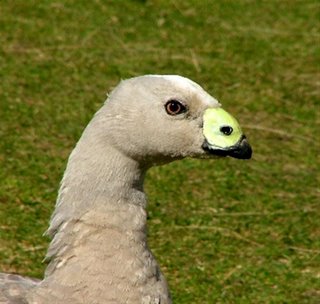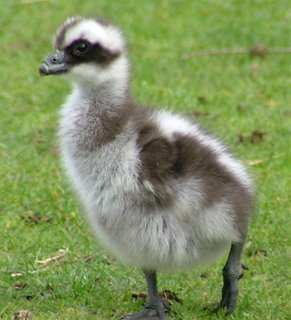World's Second Rarest Goose?
 John Tongue writes: The literature for Maria Island (a very pleasant place to spend a few days of holidays) speaks of the resident Cape Barren Geese--released there between 1969 and 1971, as part of a species preservation programme--as being the World's second rarest species of goose. Certainly, they are a species of very restricted range, both nationally, and therefore, internationally. However, they are doing very well on Maria Island! We would have noticed possibly 60 adults, mostly getting around in pairs. Many of these pairs had offspring ranging from eggs (an interesting exercise to confirm there were eggs in that pile o
John Tongue writes: The literature for Maria Island (a very pleasant place to spend a few days of holidays) speaks of the resident Cape Barren Geese--released there between 1969 and 1971, as part of a species preservation programme--as being the World's second rarest species of goose. Certainly, they are a species of very restricted range, both nationally, and therefore, internationally. However, they are doing very well on Maria Island! We would have noticed possibly 60 adults, mostly getting around in pairs. Many of these pairs had offspring ranging from eggs (an interesting exercise to confirm there were eggs in that pile o f down), through to half grown juveniles. Just around Darlington alone, there would have been about 6 or 7 family groupings, ranging from 2 to 5 goslings per family. All the grassed areas have been cropped very short by a combination of Geese, Wombats, Wallabies and Kangaroos, and the ferry operator reports groups of geese leaving the island through shortage of food, and becoming quite a pest to farmers along the East Coast. It seems the preservation programme has been highly successful, and the World's second rarest goose is doing quite nicely, thank you very much!
f down), through to half grown juveniles. Just around Darlington alone, there would have been about 6 or 7 family groupings, ranging from 2 to 5 goslings per family. All the grassed areas have been cropped very short by a combination of Geese, Wombats, Wallabies and Kangaroos, and the ferry operator reports groups of geese leaving the island through shortage of food, and becoming quite a pest to farmers along the East Coast. It seems the preservation programme has been highly successful, and the World's second rarest goose is doing quite nicely, thank you very much!
 John Tongue writes: The literature for Maria Island (a very pleasant place to spend a few days of holidays) speaks of the resident Cape Barren Geese--released there between 1969 and 1971, as part of a species preservation programme--as being the World's second rarest species of goose. Certainly, they are a species of very restricted range, both nationally, and therefore, internationally. However, they are doing very well on Maria Island! We would have noticed possibly 60 adults, mostly getting around in pairs. Many of these pairs had offspring ranging from eggs (an interesting exercise to confirm there were eggs in that pile o
John Tongue writes: The literature for Maria Island (a very pleasant place to spend a few days of holidays) speaks of the resident Cape Barren Geese--released there between 1969 and 1971, as part of a species preservation programme--as being the World's second rarest species of goose. Certainly, they are a species of very restricted range, both nationally, and therefore, internationally. However, they are doing very well on Maria Island! We would have noticed possibly 60 adults, mostly getting around in pairs. Many of these pairs had offspring ranging from eggs (an interesting exercise to confirm there were eggs in that pile o f down), through to half grown juveniles. Just around Darlington alone, there would have been about 6 or 7 family groupings, ranging from 2 to 5 goslings per family. All the grassed areas have been cropped very short by a combination of Geese, Wombats, Wallabies and Kangaroos, and the ferry operator reports groups of geese leaving the island through shortage of food, and becoming quite a pest to farmers along the East Coast. It seems the preservation programme has been highly successful, and the World's second rarest goose is doing quite nicely, thank you very much!
f down), through to half grown juveniles. Just around Darlington alone, there would have been about 6 or 7 family groupings, ranging from 2 to 5 goslings per family. All the grassed areas have been cropped very short by a combination of Geese, Wombats, Wallabies and Kangaroos, and the ferry operator reports groups of geese leaving the island through shortage of food, and becoming quite a pest to farmers along the East Coast. It seems the preservation programme has been highly successful, and the World's second rarest goose is doing quite nicely, thank you very much!
1 comment:
Reading that got me curious so I had a look at Handbook of the Birds of the World. It estimated 15 000 to 17 000 birds based on 1980s figures (that volume of HBW was published in 1991). Hawaiian Goose is the rarest. But according to thier figures, Bar headed and Emperor Geese have roughly the same numbers as Cape Barren. Others like Ruddy headed Goose weren't far ahead. So perhaps not second rarest at that time, but not far off.
Post a Comment